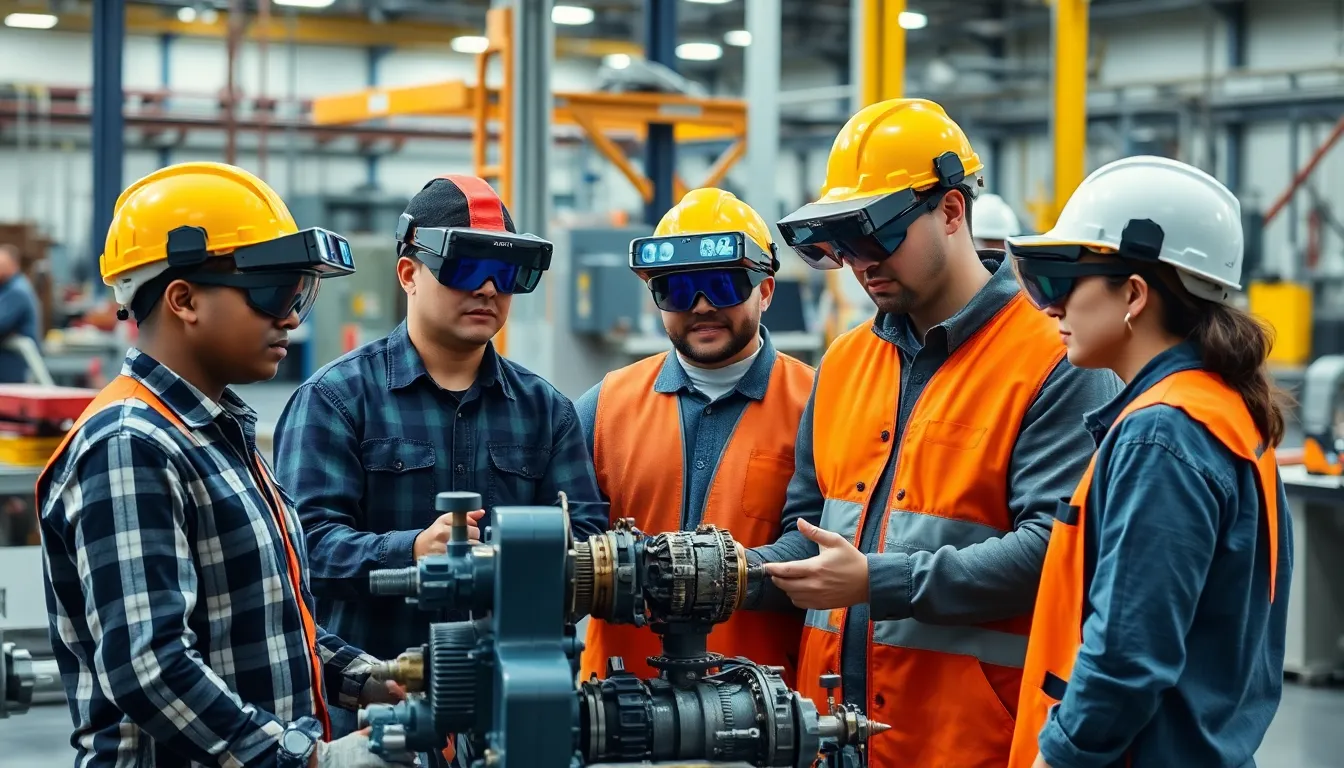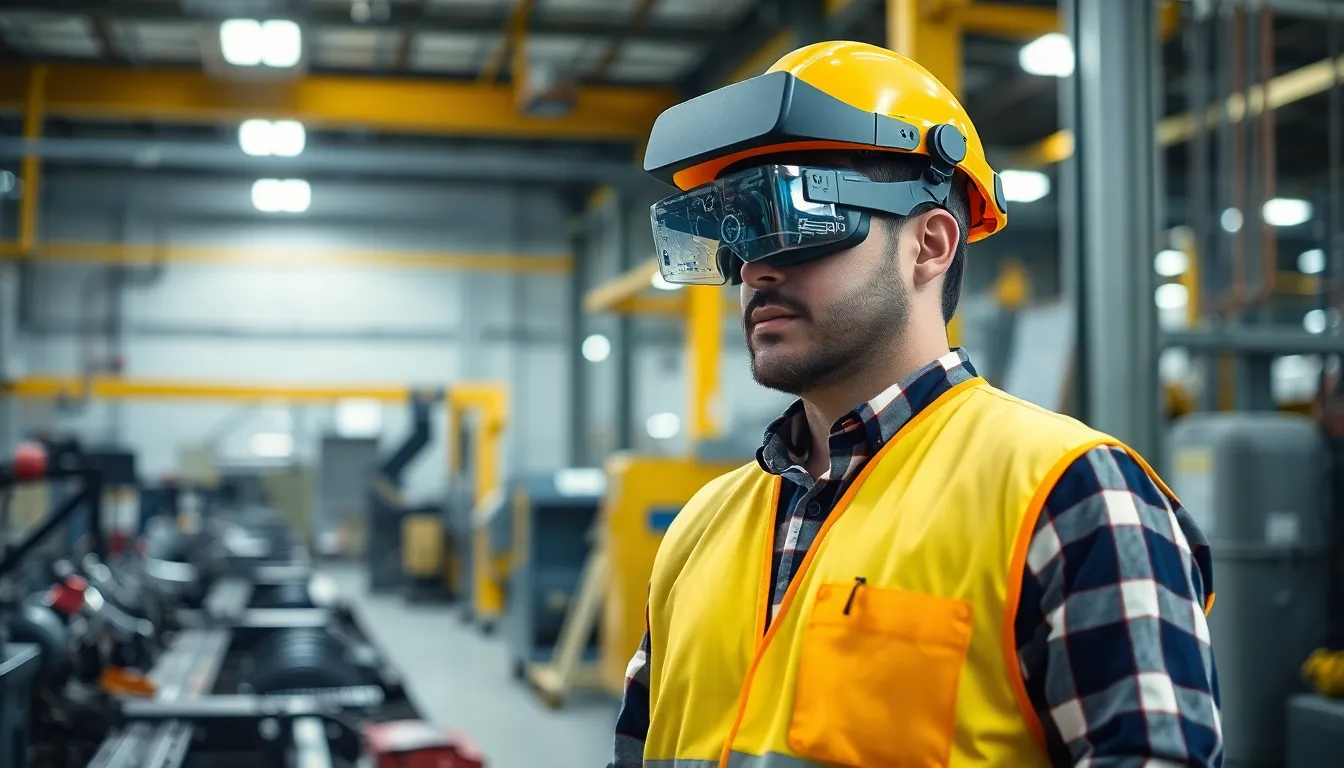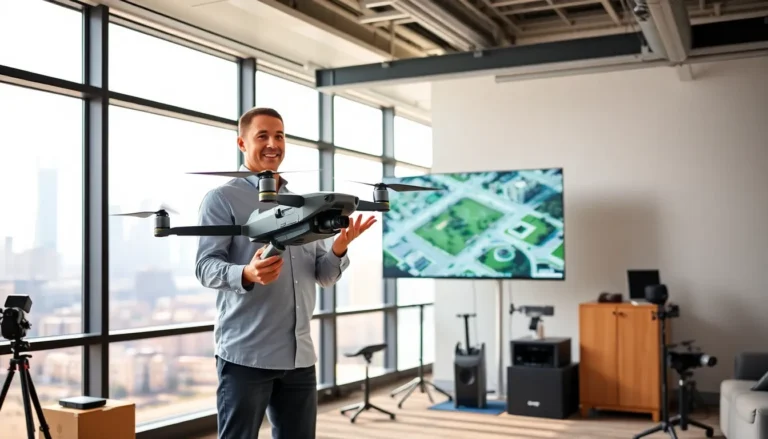In a world where robots are becoming the new coworkers and factories are transforming into high-tech playgrounds, augmented reality (AR) is leading the charge. Imagine a factory floor where workers don’t just see machines but interact with digital overlays that guide them through complex tasks. It’s like having a personal trainer, but instead of crunches, they’re perfecting assembly lines.
Table of Contents
ToggleOverview of Augmented Reality in Manufacturing
Augmented reality (AR) in manufacturing transforms how employees engage with their tasks. This technology overlays digital information onto the physical environment, allowing workers to visualize complex processes in real time. As a result, AR significantly reduces training time by providing interactive guidance directly in the workspace.
AR systems enhance efficiency by helping employees quickly locate tools and materials. They can access step-by-step instructions without needing to refer to manual documentation. Using smart glasses or mobile devices, individuals see essential data during assembly, improving accuracy and productivity on the factory floor.
Several industries benefit from AR applications. Automotive manufacturers utilize augmented reality for maintenance and repairs, allowing technicians to visualize parts and procedures. Aerospace companies leverage AR for assembly line processes, ensuring high precision in complex tasks.
Data from industry reports reveals that AR can reduce error rates by up to 30%. Additionally, it can enhance training effectiveness by providing immersive learning experiences. Companies have reported significant improvements in overall operational efficiency after integrating AR solutions.
Implementing AR requires an evaluation of technological infrastructure. Factories must assess existing systems and training needs before deployment. Partnerships with AR software providers or investment in custom solutions can facilitate successful integration.
Augmented reality in manufacturing represents a shift towards more efficient and interactive work environments. By employing this technology, manufacturers can streamline operations, enhance employee skills, and drive innovation within their organizations.
Benefits of Augmented Reality

Augmented reality (AR) offers substantial advantages in manufacturing, enhancing efficiency and effectiveness on the factory floor.
Enhanced Visualization and Design
Enhanced visualization allows workers to view digital overlays of designs directly on physical components. This capability helps identify potential issues early in the production process. Detailed instructions appear in real-time, showcasing assembly steps and machine operations. Increased accuracy results as operators visualize complex systems and components more clearly. Enhanced design tools enable engineers to modify layouts and processes easily. Successful implementations show marked improvements in project completion times and collaboration among team members. Overall, AR fosters a more intuitive work environment, leading to better outcomes.
Improved Training and Onboarding
Improved training significantly accelerates the onboarding process for new employees. AR provides interactive experiences that engage users and tailor learning to their specific roles. Instant access to digital guides allows trainees to follow along with workflows effortlessly. Enhanced understanding stems from hands-on practice supported by virtual instructions. Training programs using AR often report reduced learning times by up to 40%. This technology also lowers the cost of traditional training methods by minimizing the need for lengthy classroom sessions. Engaging multimedia resources help reinforce knowledge retention long after initial training is complete.
Applications of Augmented Reality in Manufacturing
Augmented reality reshapes manufacturing through various applications, significantly enhancing productivity and precision.
Assembly and Maintenance
AR assists in assembly and maintenance tasks by providing real-time instructional overlays. Workers see digital guidance directly on components, helping them follow complex procedures accurately. This technology reduces assembly errors while speeding up the process. In industries like automotive and aerospace, AR decreases maintenance downtime by up to 20%. Technicians access step-by-step repair instructions instantly, boosting efficiency and safety on the factory floor. By utilizing AR, companies enhance employee confidence and reduce the need for extensive manual references during critical tasks.
Quality Control
Quality control benefits tremendously from augmented reality through improved inspection processes. Inspectors use AR to visualize specifications superimposed on actual products, allowing them to spot defects more easily. Enhanced visualization leads to a 30% reduction in error rates during inspections. Workers can reference specifications and previous designs side by side, ensuring higher accuracy. Additionally, real-time feedback improves communication among team members, facilitating faster adjustments and corrections. The integration of AR elevates standards for quality assurance, directly contributing to increased customer satisfaction.
Challenges and Limitations
Augmented reality in manufacturing faces several challenges and limitations. Addressing these issues is essential for maximizing AR’s potential within production environments.
Technical Barriers
Technical barriers pose a significant challenge to AR adoption. Existing infrastructure often lacks compatibility with AR systems, leading to integration difficulties. Device limitations prevent some workers from fully engaging with the technology. Moreover, the necessity for high-speed internet connections further complicates implementation in certain facilities. Training employees on new systems can lead to delays as well, especially when staff members require time to adapt to AR tools. Ensuring that AR solutions effectively complement existing workflows remains a crucial consideration for manufacturers.
Cost Considerations
Cost considerations can deter manufacturers from adopting augmented reality technologies. Initial investments in AR hardware and software can appear substantial, especially for small to medium-sized enterprises. Ongoing maintenance and updates add to the financial burden, making it vital to analyze the return on investment. Organizations might face challenges securing funding for AR projects, often requiring justifications based on projected efficiency gains. Furthermore, customizing AR solutions to specific operational needs can lead to increased expenses, impacting overall budget allocations. Strategic planning is needed to ensure cost-effective implementation while maximizing the benefits of AR in manufacturing.
Future Trends in Augmented Reality in Manufacturing
Emerging trends in augmented reality (AR) are shaping the future of manufacturing. First, advancements in AR technology will enhance real-time data analytics, enabling workers to access metrics and insights instantly. This increased accessibility promotes informed decision-making and improves operational efficiency.
Next, artificial intelligence will integrate with AR to create adaptive training programs. These programs will customize learning experiences based on individual employee performance, leading to even lower training times and costs. Companies can expect onboarding processes to become more efficient, as AI-driven AR tools can adapt to various learning styles.
In addition, the growth of 5G networks will facilitate smoother AR experiences. Faster internet connections can support more complex applications and enable seamless streaming of digital overlays, enhancing collaboration among teams. Workers can access detailed instructions or project specifications without delay, reducing risks and improving productivity.
Another trend involves the transition from hardware-based AR solutions to cloud-based platforms. This shift will enable manufacturers to scale AR solutions more easily and reduce costs associated with hardware maintenance. Companies can quickly adopt new features and upgrades that improve overall functionality.
Furthermore, standardized AR applications will play a crucial role in promoting interoperability across different manufacturing systems. Consistency in software will ensure that AR tools can be seamlessly integrated into existing operational frameworks, enhancing user experience and minimizing technical barriers.
Finally, advancements in AR will lead to enhanced remote collaboration capabilities. Teams can visualize designs and troubleshoot issues in real-time, regardless of location. This trend supports communication and speeds up project timelines, contributing to overall productivity in manufacturing.
Augmented reality is reshaping the manufacturing landscape by enhancing efficiency and accuracy. Its ability to overlay digital information onto the physical workspace empowers employees to navigate complex tasks with ease. This technology not only accelerates training but also fosters collaboration and improves quality control processes.
As AR continues to evolve with advancements in artificial intelligence and cloud solutions, its potential in manufacturing will only grow. Organizations that strategically implement AR can expect significant gains in productivity and reduced error rates. Embracing this innovative approach will be crucial for manufacturers aiming to stay competitive in an increasingly digital world.





